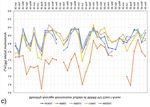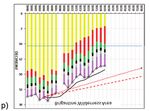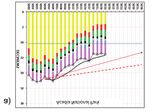The Changing Nature of Visibility Impairment - NESCAUM
←
→
Page content transcription
If your browser does not render page correctly, please read the page content below
Visibility in the MANE-VU Region by Sharon Davis, David Healy, and Alexandra Karambelas
The Changing Nature
of Visibility Impairment
in the Mid-Atlantic/Northeast
Visibility Union (MANE-VU) Region
MANE-VU Class 1 Areas (clockwise from top left): Moosehorn Wilderness Area (ME), Roosevelt Campobello International Park
(New Brunswick, Canada), Lye Brook Wilderness Area (VT), Brigantine Wilderness Area (NJ), Presidential Range–Dry River
Wilderness Area (NH), and in the center, Acadia National Park (ME).
by Sharon Davis, David Healy, and Alexandra Karambelas
Assessing the progress made in improving visibility at federally protected Class I
areas located in MANE-VU states, the changing nature of regional haze in the
Northeast, and the steps needed to continue progress in visibility improvement
across the MANE-VU region.
em • The Magazine for Environmental Managers • A&WMA • April 2022Visibility in the MANE-VU Region by Sharon Davis, David Healy, and Alexandra Karambelas
Under the U.S. Clean Air Act, Class I designation was The first round of SIPs, due in 2008, assessed the milestone
given to 156 national parks, wilderness areas, memorial year of 2018. For states in the Mid-Atlantic/Northeast Visibility
parks, and international parks across the United States. Union (MANE-VU) region (see Figure 1), these SIPs identified
The U.S. Environmental Protection Agency (EPA) promul- sulfur dioxide (SO2) as the predominant precursor to visibility
gated the 1999 Regional Haze Rule (RHR) that set goals impairment. Thus, the reductions implemented for the first
for states to achieve natural visibility conditions (i.e., no 10-year planning period focused on reducing SO2 emissions
human-caused visibility impairment, in Class I areas by from sources such as power plants and large industrial boilers.
2064). Per the RHR, all states—even those without Class I
areas—are required to develop a State Implementation Plan MANE-VU states recently completed the second phase of
(SIP) to outline how they intend to contribute to progress RH planning, which covers the period 2018–2028. As part
toward natural visibility conditions by 2064. States with of this phase, the MANE-VU states evaluated emissions
Class I areas are further required to establish reasonable inventory trends and regional haze metric trends from
progress goals for Class I areas within their borders. States the baseline period of 2000–2004 to the most current
must submit a regional haze SIP revision every 10 years, period. Measurements confirmed that large SO2 emissions
along with corresponding five-year progress reports, to reductions were achieved, and that other pollutants, mainly
document reasonable progress towards the 2064 goal of nitrates, are now more important contributors, changing the
natural visibility conditions. nature of haze in the region.
Emissions Trends
Visibility impairment is primarily
caused by light scattering and ab-
sorption from aerosols. Aerosols may
be emitted by anthropogenic sources
such as combustion processes or by
natural sources such as lightning-
caused wildfires, or they may be
formed through secondary reactions
in the atmosphere. Secondary
aerosols in MANE-VU often result
from emissions of SO2 and oxides of
nitrogen (NOX) reacting with ammo-
nia to form ammonium sulfate and
ammonium nitrate, respectively.
MANE-VU uses data from emissions
inventories and in situ observations to
assess progress toward natural visibil-
ity in Class I areas.
Figure 2a shows the trend in annual
MANE-VU state total SO2 emissions
for 2002–2017 from EPA’s National
Emissions Inventory (NEI) and from
sources such as power plants and
large industrial facilities that report
directly to EPA’s Air Markets Program
Database (AMPD) (hatched bars).
There is a clear downward trend in
total SO2 emissions that is largely
driven by a decline in SO2 emissions
from AMPD sources, which are an
Figure 1. Map of MANE-VU region. Class I areas indicated with
overwhelming contributor to total
black stars. Nearby Class I areas outside of MANE-VU indicated with
SO2 emissions. Because large point
blue circles.
source emission reductions were a
em • The Magazine for Environmental Managers • A&WMA • April 2022Visibility in the MANE-VU Region by Sharon Davis, David Healy, and Alexandra Karambelas
The Mid-Atlantic/Northeast Visibility Union (MANE-VU)
MANE-VU includes 11 states—Maine, Vermont, New Hampshire, Rhode Island, Massachusetts, Connecticut,
New York, New Jersey, Pennsylvania, Delaware, and Maryland—as well as the District of Columbia, the
Penobscot Nation (ME), and the St. Regis Mohawk Tribe (NY). The MANE-VU Regional Planning Organization
was formed to coordinate actions necessary to improve visibility at national parks and wilderness areas in the
Northeast and Mid-Atlantic region. MANE-VU provides support to its member agencies by facilitating technical
assessments, evaluations of regional air pollution, forums for discussion, and coordination with other regions.
A Technical Support Committee assesses the nature of regional haze, the sources that contribute to regional
haze, and the technical tools that states can use to develop their programs.
focus of the first regional haze planning phase, federal and effort was focused on reducing SO2 emissions and AMPD
state regulations to reduce these emissions contributed to a sources are a moderate contributor to NOX. Further,
decline in coal use. This, in turn, led to reductions in SO2 former and current stationary source NOX emission
emissions at AMPD sources. Further, the economics of natural control programs, such as the NOX SIP Call, the Clean
gas availability have likely contributed to recent reductions in Air Interstate Rule, and the Revised Cross State Air Pollution
SO2 emissions, and state interest in renewable energy initia- Rule Update, are mainly focused on reducing ozone
tives may be contributing to the decline in coal use and the pollution; therefore, most of the associated NOX reductions
associated reduction in SO2. occur during the summer ozone season. To address regional
haze, MANE-VU has found that year-round NOX controls
Similarly, annual NOX emission trends for state total and are needed.
AMPD contributions (hatched bars) in the MANE-VU region
show a clear downward trend between 2002 and 2017 (see The impact of the reduced SO2 and NOX emissions can
Figure 2b), though declines are not quite as steep as for be seen in the sulfate and nitrate measurements from the
SO2. This is, in part, because the first regional haze planning Interagency Monitoring of Protected Visual Environments
White Paper Offers
Illegal Dumping
Prevention, Mitigation Best Practi
ce
Dumping O s In Addressing Illeg
al
f Durable W
Strategies For Policy
Correspon
Secondary
Makers
ding Autho
aste – A G
r: Dr. Calvin
uide
Lakhan
Author: Na
na Adjei
In Best Practices in Addressing Illegal Dumping of Faculty of
Environmen
tal and Ur
ban Chan
Durable Waste authors, Dr. Calvin Lakhan and Nana ge
Adjei of York University, identify the drivers of illegal
dumping of durable, often bulky items, as well as
approaches to address the problem. Topics include:
• Improving access to proper disposal options
• Raising awareness
• Physical prevention strategies
• Strengthening enforcement
Download Your FREE Copy
MattressRecyclingCouncil.org/Illegal-Dumping
em • The Magazine for Environmental Managers • A&WMA • April 2022Visibility in the MANE-VU Region by Sharon Davis, David Healy, and Alexandra Karambelas
(IMPROVE) visibility monitoring
network. Sulfate concentrations
(µg/m3) decline considerably from
2000 to 2020 for all MANE-VU
Class I areas (see Figure 3a).
Nitrate concentrations trended
downward to a trough around
2010 and then generally leveled
off until 2020 at all Class I areas
except Brigantine Wilderness
Area, which did not reach a low
point and level off until 2017 (see
Figure 3b). In general, sulfate
peaks in summer (see Figure 3c)
while nitrate peaks in winter (see
Figure 3d). In the winter, nitrogen
dioxide (NO2), a component of
NOX, exhibits a longer lifetime
due to colder temperatures and
increases the potential for conver-
sion to nitrate rather than being
removed from the atmosphere.
Nitrate is also more stable under
cooler conditions, leading to
higher concentrations.
Regional Haze
Metric Trends
Progress toward natural visibility
conditions is evaluated using data
collected from the IMPROVE visi-
bility monitoring network. EPA
guidance requires regional haze
SIPs to focus on improving visibil-
ity on the 20% most impaired
Figure 2. (a) Statewide total SO2 emissions (height of bar) and SO2 days—that is, the 20% worst
emissions from EPA Air Markets Program Data (AMPD) sources visibility days accounting only for
(hatched area) in the MANE-VU states (2000–2017). (b) Statewide total anthropogenic sources of visibility
NOX emissions (height of bar) and NOX emissions from AMPD sources impairment.1 Since 2000, there
(hatched area) in the MANE-VU states (2002–2017). has been a seasonal shift in the
20% most impaired days. From
To address regional haze, MANE-VU has found
that year-round NOX controls are needed.
em • The Magazine for Environmental Managers • A&WMA • April 2022Visibility in the MANE-VU Region by Sharon Davis, David Healy, and Alexandra Karambelas
Figure 3. Annual average (a) sulfate and (b) nitrate concentrations (µg/m3) at MANE-VU Class I areas
(2000–2020). Monthly average (c) sulfate and (d) nitrate concentrations (µg/m3) at MANE-VU Class I
areas (January 2018–December 2020). In all panels, observations at Acadia are shown in dark blue,
Brigantine are in orange, Great Gulf Wilderness are in gray, Lye Brook are in yellow, and Moosehorn
are in light blue. In (b), some of the Class I area 2019 nitrate concentrations may be artificially low due
to missing January data.
2000 through 2012 for most MANE-VU Class I areas, most from baseline 2000–2004 visibility levels to the 2064
of the 20% most impaired days occurred during the sum- natural visibility conditions goal. However, current five-year
mer months (see Figure 4, red bars), when sulfates tend to average haze indices for the 20% most impaired days are
dominate the aerosol fraction. However, since 2013, most not at or below the level of the 2028 RPGs. Therefore,
have occurred during winter months (see Figure 4, blue further progress is needed to achieve 2028 RPGs at all
bars), when the nitrate fraction contribution increases. Spring MANE-VU Class I areas. While not all MANE-VU states’
and fall contributions to 20% most impaired days fluctuate RH SIPs have been finalized, MANE-VU used photo-
year to year and don’t exhibit a notable trend. chemical modeling to establish RPGs for 2028.2
Annual and five-year rolling average haze indices, measured Conclusions
in deciviews, at MANE-VU Class I areas are compared to MANE-VU Class I areas are realizing visibility improve-
Uniform Rate of Progress (URP, red dashed line) and Rea- ments, but states in the region are no longer able to
sonable Progress Goal (RPG, black crosshatch at 2028 and prioritize emission reductions for one pollutant alone.
red-dotted glide path) projections in Figure 5. URP and Haze indices on the 20% most impaired days have
RPGs are calculated metrics used in regional haze SIPs to decreased considerably since 2000, primarily due to
evaluate progress toward the goal of natural visibility condi- decreases in sulfate concentrations. However, nitrate
tions. Annual haze indices (black line with circles) at repre- contributions are collectively becoming a larger factor in
sentative MANE-VU Class I areas are below the URP, visibility impairment, reflecting a seasonal shift such that
meaning that current haze indices for the 20% most im- a majority of 20% most impaired days in the MANE-VU
paired days are already below the level of the glide path region occur during winter months.
em • The Magazine for Environmental Managers • A&WMA • April 2022Visibility in the MANE-VU Region by Sharon Davis, David Healy, and Alexandra Karambelas
Figure 4. Seasonal contributions to 20% most impaired days 2000–2019 at two MANE-VU Class I
areas: (a) Acadia National Park and (b) Brigantine Wilderness Area.
Figure 5. Visibility metric trends for 20% most impaired days 2000–2019 for two MANE-VU Class I areas:
(a) Acadia National Park and (b) Brigantine Wilderness Area. Glide-paths for the URP are shown in red
dashed lines, and RPGs are shown in red dotted lines. The black line is the five-year average Haze Index.
Reductions in sulfate and nitrate concentrations over time, et al.4 found that if SO2 emissions were to decrease while
although significant, are not as steep as the downward trends NOX emissions remained at 2015 levels, projected nitrate
in their precursor SO2 and NOX emissions across sites in concentrations may even increase in the future. Therefore,
MANE-VU Class I areas. Recent research into the reduction concurrent reductions of NOX and SO2 emission are needed
of gaseous emissions in the eastern United States found that during the winter to realize meaningful decreases in winter-
although SO2, NO2, and particulate sulfate have declined time nitrate concentrations. It is important to move forward
considerably, particulate nitrate concentrations in the winter- with a multi-pollutant, year-round focus to achieve the 2028
time have remained largely unchanged.3,4 In one case, Shah RPGs in Class I areas across the MANE-VU states to continue
em • The Magazine for Environmental Managers • A&WMA • April 2022Visibility in the MANE-VU Region by Sharon Davis, David Healy, and Alexandra Karambelas
making progress towards the 2064 goal of reaching natural called for implementation of this measure in its own states as
visibility conditions. For these reasons, the MANE-VU states well as upwind states that contribute to visibility impairment at
included as a measure in their second regional haze planning MANE-VU Class I areas. MANE-VU will continue to support
SIPs the year-round operation of existing NOX controls for more year-round NOX control measures, as well as measures
large sources such as coal-fired power plants.5 MANE-VU that will reduce SO2 emissions. em
Sharon Davis is the Manager of the Bureau of Evaluation and Planning at the New Jersey Department of Environmental Protection
and is Co-Chair of the MANE-VU Technical Support Committee. Email: Sharon.davis@dep.nj.gov. David Healy
is a Senior Scientist at the New Hampshire Department of Environmental Services and is Co-Chair of the MANE-VU Technical Support
Committee. Email: David.s.healy@des.nh.gov. Alexandra Karambelas, Ph.D., is an environmental analyst with Northeast States
for Coordinated Air Use Management (NESCAUM), a regional organization providing technical and policy advice to the air quality
agencies of eight northeastern states. Email: akarambelas@nescaum.org.
Disclaimer: The views and opinions expressed in this article are those of the authors and do not represent the official views of the
participating agencies.
Acknowledgment: Portions of the work described in this article were developed by Tom Downs, Chief Meteorologist, Maine Depart-
ment of Environmental Protection, and are jointly supported by the state air quality agency members of MANE-VU. Data collected for
MANE-VU can be accessed at https://otcair.org/manevu/.
References
1. U.S. Environmental Protection Agency (EPA). Guidance on Regional Haze State Implementation Plans for the Second Implementation Period, August 10, 2019;
https://www.epa.gov/visibility/visibility-guidance-documents.
2. Mid-Atlantic/Northeast Visibility Union (MANE-VU). Ozone Transport Commission/Mid-Atlantic Northeastern Visibility Union 2011 Based Modeling Platform
Support Document – October 2018 Update, October 18, 2018; https://otcair.org/MANEVU/Upload/Publication/Reports/OTC%20MANE-
VU%202011%20Based%20Modeling%20Platform%20Support%20Document%20October%202018%20-%20Final.pdf.
3. Feng, J.; Chan, E.; Vet, R. Air quality in the eastern United States and Eastern Canada for 1990–2015: 25 years of change in response to emission reductions
of SO2 and NOX in the region; Atmospheric Chemistry and Physics 2020, 20 (5), 3107-3134; https://doi.org/10.5194/acp-20-3107-2020.
4. Shah, V.; Jaeglé, L.; Thornton, J.A.; Lopez-Hilfiker, F.D.; Lee, B.H.; Schroder, J.C.; Campuzano-Jost, P.; Jimenez, J.L.; Guo, H.; Sullivan, A.P.; Weber, R.J.; Green,
J.R.; Fiddler, M.N.; Bililign, S.; Campos, T.L.; Stell, M.; Weinheimer, A.J.; Montzka, D.D.; Brown, S.S. Chemical feedbacks weaken the wintertime response of
particulate sulfate and nitrate to emissions reductions over the eastern United States; Proceedings of the National Academy of Sciences 2018, 115 (32), 8110-
8115; https://doi.org/10.1073/pnas.1803295115.
5. Mid-Atlantic/Northeast Visibility Union (MANE-VU). Statement of the Mid-Atlantic/Northeast Visibility Union (MANE-VU) States Concerning a Course of
Action Within MANE-VU Toward Assuring Reasonable Progress for the Second Regional Haze Implementation Period (2018–2028), August 25, 2017;
https://otcair.org/MANEVU/Upload/Publication/Formal%20Actions/MANE-VU%20FLM%20Final%20Ask%208-25-2017.pdf.
39TH INTERNATIONAL CONFERENCE
ON THERMAL TREATMENT TECHNOLOGIES
& HAZARDOUS WASTE COMBUSTORS
May 5-6, 2022 • West Palm Beach, FL
Attend the premier conference on thermal treatment technologies!
Now in its 39th year, IT3/HWC provides a forum for the discussion of Panels and technical sessions will cover:
state-of-the-art technical information, regulations, and public
• Keynote – Recasting the Role of Municipal Solid
policy on thermal treatment technologies and their relationship to
Waste Incineration in the Future of Integrated Solid
air emissions, greenhouse gases, sustainability, and climate change.
Waste Management
Attend the technical tour to the Solid Waste Authority of Palm • PFAS Thermal Treatment Perspectives
Beach County on Wednesday, May 4! • Combustion of Fluorinated Organic Compounds
• PFAS and Waste Incineration
Sponsorship and display opportunities are still available. Choose • PFAS Emission Control Strategies
from various levels to meet your company’s needs. • Aspects of Waste Incineration
• Advancements in Air Pollution Control Technologies
Thank you to our Gold Sponsors!
A pre-conference virtual course will be offered
on April 26 and 28 on Air Pollution Control.
Register now and find the complete conference program at www.awma.org/IT3.
em • The Magazine for Environmental Managers • A&WMA • April 2022You can also read



























































